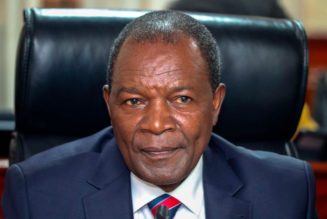Columnists
Restructure the domestic debt
Tuesday April 11 2023
Prof Njuguna Ndung’u, Cabinet Secretary for National treasury and planning on October 18, 2022. PHOTO | DENNIS ONSONGO | NMG
The government has committed two cardinal sins when it comes to financial markets. First, you don’t signal a fiscal disorder. Doing so invites a bloodbath.
Deputy President Rigathi Gachagua has repeatedly used political podiums to convey disorder in public finances. The Treasury Cabinet Secretary has also done the same in some fora.
When it comes to weak fiscal trajectory, the Government ought to maintain a policy of ambiguity, that is, neither deny nor confirm. This then removes any overhang in the market and leaves the market in a pricing dilemma, to the advantage of the Treasury.
However, assuming an explicit posture is akin to handing the market powder keg.
Secondly, you don’t walk back on your fiscal restoration plans, especially after communicating it. You lose credibility. The President had unveiled bold plans to shrink the budget for the current fiscal year by Sh300 billion through a Supplementary budget.
Instead, the actual supplementary budget only adjusted the ministerial expenditure downwards by Sh14.7 billion by way of reducing development budget by Sh106.3 billion and increasing the recurrent budget by Sh92.97 billion.
Furthermore, the budget for the next fiscal year 2023/24 doesn’t convey fiscal prudence.
Committing these two cardinal sins has triggered short-termism in the market. For instance, between January and April 2023, the Treasury had offered Sh170 billion worth of bonds but only received bids worth Sh124.5 billion (excluding the tap sales), representing a performance rate of 73 percent.
At the same time, auction of treasury bills recorded a performance rate of 112 percent. In essence, investors don’t want to lend to the Government beyond one year until there is clarity on the fiscal situation.
So, what options does the Government have in the current situation? Top of the list should be to restructure domestic debt. Domestic debt service accounts for 74 percent of total public debt service even though it accounts for only 48 percent of total debt stock.
In comparison, external debt, while accounting for 52 percent of total debt stock, accounts for only 26 percent of debt service. This implies that restructuring domestic debt can have a greater impact on alleviating the current debt-service burden.
The restructure would involve further lengthening the maturity profile of existing domestic debt and repricing downwards, which implies a haircut on interest.
Additionally, they may also consider temporary fiscal expansion. And for this, the Treasury has to go to Parliament.
And it goes like this: Section 46 of the Central Bank of Kenya (CBK) Act allows the bank to make direct advances to the government for the purpose of offsetting fluctuations between receipts from the budgeted revenue and payments of the government on condition that it is secured by negotiable securities with a maturity of not later than 12 months.
Further, the Act directs that total advances to the government shall not exceed five percent of last audited revenues. With this in mind, the Treasury can issue a bond enough to cover the fiscal gap, or even more, being a negotiable security, in favour of the CBK and in exchange for full subscription.
To execute this, Parliament needs to amend the CBK Act to extend the tenure of such a negotiable security to beyond 12 months; and, increase the cap of advanceable funds to the government to beyond the current five percent (of audited revenues).
However, fiscal expansion tend to have inflationary impacts on purchasing power. Consequently, there has to be a plan to gradually sterilise the money.









